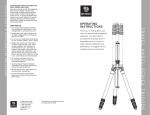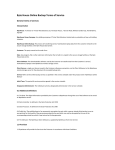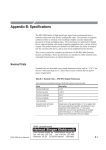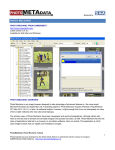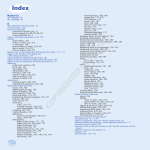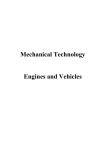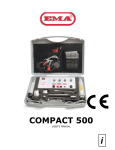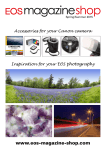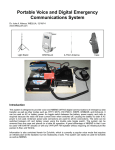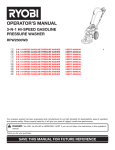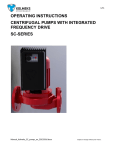Download How to have a successful photo trip
Transcript
How to have a successful photo trip (by Reed Hoffmann, copyright 2011, not to be shared without permission.) How can you get the most out of your photo trip? Good trips begin with research, planning and preparation. What to take and how to get it there safely, keeping your gear clean and working, finding great pictures, dealing with electrical systems (or a lack thereof), advantages and disadvantages of taking a computer, netbook, digital wallet or cards are all important. And how do you develop and use a digital workflow optimized for travel? I’ve traveled the U.S. and the world for the last 15 years, from the jungles of Borneo to the top of Mount Kilimanjaro, both on assignment and leading photo trips. Let me share my tips to making any photo trip a successful one. Planning and Packing First on your list should be research. Take advantage of your local library’s vast resources on people and places around the world. Seek out magazine articles, guidebooks, internet postings. Use Flickr, Google Earth and other online resources to do a virtual tour of the place without ever leaving home. Read about the history and culture of the area. Find out what’s acceptable, what’s not. That goes for clothing as well as gestures and greetings. In conservative societies, just plan on wearing long sleeved shirts and long pants. No one is offended by that, and shorts and sleeveless tops are often considered inappropriate for religious places. Learn about the customs, such as removing shoes when entering homes or sacred places. Learn how to say a few words in the local language. Just being able to say “Hello” and “Thank-‐you” will show some respect for the people there. There are always limits on how much luggage you can take with you, and how large the bins are on the different planes you’ll be flying in. Know that what the airline lets you check and carry-‐on in the states may not extend to air travel outside the U.S. And when taking local flights in-‐country, there may be tighter restrictions. For instance, travel to places like the Galapagos Islands of Ecuador and around Africa is often limited to about 40-‐lbs for checked luggage, and perhaps just a small bag for carry-‐on. And when flying home, the regulations at the departure airport could be different than when you flew in. A little research into this beforehand can save a headaches and money later. If possible, try to make do with one piece of checked luggage. Rolling duffel bags are great for this sort of thing. They’re easy to handle and pull along, and can usually accommodate a collapsed tripod. Plus soft-‐sided luggage is lighter than hard-‐sided. If you’re limited on weight, don’t bring a bag that weighs 15 lbs. empty. And you’ll find that the less baggage you have, the easier your travel will be. Not all places have porters and elevators, so realize you may have to haul your own bags up and down stairs and long distances. If you try to keep the weight around 40 lbs or less, you’ll have fewer problems with weight restrictions and save your back as well. The kit above is what I took for 12-‐day trips to the Galapagos Islands and Tanzania. The roller bag was 40 lbs (checked), the backpack 25 lbs (carried) and waist pack 6lbs (carried). Make sure your passport is up to date, with at least six months before expiration (some countries require that before entry). Have several copies of your passport’s main page and keep them in different places in your luggage. If your passport is lost or stolen, having that copy can expedite getting it replaced. You can’t get home without one. Think about how you’ll carry your passport. Pants pocket or purse is not the best place, nor your camera bag. It’s too easy for those to get lost or stolen. Better to use a document wallet you can wear around your neck under your shirt, or a money belt. You’ll find some travel shirts (Ex Officio for one) have zippered chest pockets in some of their shirts just for this. Many hotels now have small safes in the room, and that’s a good place to keep it while there. Find out if a visa is required to enter the country. If so, do you need to get it in advance or can it be purchased upon entry? If it has to be done in advance, you’ll normally need to send your passport to one of that country’s embassies well ahead of your trip. If you buy one upon entry, remember that everyone on the plane may need to do that too, so get to the window or desk as quickly as possible. Sometimes one person in the group can get everyone’s visas. That way one person can take care of that and the others can collect luggage. And always, always keep an eye on your gear. I had a friend who after a long flight to India arrived with his wife and baby bleary-‐eyed. In the process of collecting luggage, dealing with Immigrations and Customs, getting through the airport and finding a taxi, it wasn’t until they got to the hotel that he realized his camera bag was missing. You don’t want to start a photo trip by shopping for new camera equipment in a foreign country. When it comes to money, take more cash than you think you’ll need. Credit cards are good to have too, but everyone accepts U.S. money. However, make sure and get new bills. In some places they won’t accept US dollars that are crumpled, folded, written on or even worse, torn. Large bills take less space than small bills. I often carry several hundred-‐dollar bills as emergency money, then fifties, twenties and tens. You’ll usually get the best exchange rates at banks, but it’s often easier to just change some money at the airport when you arrive. Sometimes shops are set up to do that inside baggage claim, so you can change money while waiting for your bags. Just be aware that they usually charge a per-‐transaction fee. ATM’s are also an easy way to get money, and worth finding out what the fee is to use one with your card(s). The hotels you’re staying at will also usually change money for you, without an added fee. You may need local money right away, for taxis or tips for porters. For those tips, I find it easiest just to take a stack of $1 bills. Otherwise you’ll constantly be trying to get smaller bills and change in local currency, which can be difficult. Photographers love their bags. Shoulder bags, backpacks, waist packs, you name it, we’ve got them. And each have their place. For me, a backpack’s a great way to travel with camera gear. Some companies (like Thinktank Photo) make backpacks specifically designed for flying, and some of them fit the smaller overhead compartments on commuter planes. My favorite, the Thinktank Airport Essentials, measures just 18" x 11.5" x 7". With the dividers removed (and my gear padded by t-‐shirts, socks and underwear), I can carry my gear for a photo safari as well as a small laptop and the total is under 25lbs. To keep weight down, I avoid backpacks with wheels. My normal photo kit includes one DX and one FX body, 16-‐ 35 f/4, 50mm f/1.8, 70-‐200 f/2.8 (or if on a wildlife trip the 80-‐400mm f/4.5-‐5.6 or 24-‐120mm f/4 and 200-‐400 f/4), TC-‐14e teleconverter, SB-‐700, batteries, cards, filters and chargers. In other words, if I get there and my checked luggage doesn’t, I can still shoot. And, the backpack is a great way to protect the gear while bouncing around in trucks, buses and taxis. However, I don’t normally like to work out of a backpack. Too much trouble taking it off to get to the equipment. For that I prefer a shoulder bag or waist pack. Shoulder bags are great for having your gear easily accessible. And if I’m on a fairly short shoot I still enjoy using them. But after four decades of carrying bags, my neck and shoulders get sore easily. And I know that I can carry more weight more comfortably on my hips. So if I’m going to be out for a long period shooting, I prefer to use a belt system to carry that weight. My preference is usually a waist pack, and then add side pouches for extra equipment I may need. Again, Thinktank has great options there, as well as Lowepro. My favorite combo the last few years is the Thinktank Speed Demon, with two or three extra pouches – one for a 70-‐200, one for a wide zoom, and a net pouch that can hold a water bottle, strobe or converter. And there are options for carrying the cameras in addition to the common neck strap. I’ve really enjoyed using an across-‐the-‐shoulder strap, like those by CarrySpeed or BlackRapid. In addition to getting the camera off my neck, there’s no chance of the strap slipping off my shoulder, and that also means it would be harder for a thief to grab it and run. The CarrySpeed is my current favorite because I can get it with an Arca-‐Swiss plate (the CarrySpeed FS model) to easily use it on my tripods. Clothing and Personal I’ve never been accused of being fashionable. For me, comfort has always trumped looking good. And here’s why: if I’m hot, tired, cold, wet or hungry, then it’s harder to concentrate on making good pictures. So I try to dress for the weather I expect, and be prepared for the unexpected. I’m an old Boy Scout – I live by the motto, “Be Prepared.” In hot weather, you’ll rarely find me in shorts and t-‐shirts unless I’m indoors. Outside in the sun, even in 100-‐degrees, I’ll be in long sleeves and long pants. There’s a reason desert peoples dress in robes – they want to avoid the sun. Long pants and shirts that are lightweight and breathable will be more comfortable than shorts. And sunburn not only hurts, it dehydrates you and can lead to skin cancer. If you’re in a buggy place those sleeves and pants mean you may only need bug dope on your hands and head. Plus, the synthetic fabrics often used in these clothes are easily hand-‐washed and dry quickly, meaning you can pack less clothes. Keeping your skin out of the sun goes for your head as well. Forget that baseball cap you love. You need a wide-‐brimmed hat that will shield not just your face but your ears and neck as well. And make sure it has a neck strap – it’s no good to you if it blows off into the water or over the cliff. Sunscreen is great, but I only carry a small bottle of it. I’m not a big fan of the sticky stuff, but with a good hat and clothes, the only place I normally need it is on my hands. While the tops of your hands can take quite a lot of sun, the skin between the fingers can get burned during a long day. About the only time I’ll put sunscreen on my face is if I’m on a boat, or on sand or snow. In that case, the sun’s reflection can burn you, and in particular get your neck and nostrils (the light’s coming from below). A great way to stay cooler on a hot day is to wear a wet kerchief around your neck. The evaporation of water in the cloth will provide a soothing balm on your neck, and your whole head will feel cooler. While I don’t like to shoot photos while wearing sunglasses (they can change the look of scenes and make it harder to see clearly through the viewfinder), they’re good to have if you’re going to spend a long day out in the. Just remove them occasionally to see what the scene really looks like. If you’re in hot weather, or even cool weather at higher altitudes (6000-‐ft or above), you’ll dehydrate quickly. That can lead to headaches and other bad things. To avoid this, force yourself to drink plenty of water. If you’re not a fan of plain water, then bring along some sugar-‐free (they’ll be much lighter) mixes to pour into it. Remember that soda and alcoholic drinks aren't as good at replenishing fluids. For cold weather try to think in layers. That makes it easy to adjust the clothing for how warm or cold you are. A thin set of long underwear as base layer, pants and shirt, wind or rain pants, fleece vest or jacket, then rain jacket. As comfortable as cotton is, I leave it at home. When cotton gets wet, it takes a lot of heat to dry it. In the cold, a wet cotton shirt will suck body heat from you all day long. Synthetics dry rapidly, and things like fleece and wool (though heavy) maintain their ability to keep you warm even when wet. A good (or better yet, great) warm hat is essential. And it needs to cover your ears or they’ll be falling off. A little wind on a moderate day can make forty-‐degrees feel like twenty. If you can’t feel your fingers, you’ll have a hard time taking pictures. Gloves that block the wind but are still supple enough to control your camera are a must. In very cold conditions, consider a thin pair of gloves with a mitten, or an overmitt, on top. Your footwear is obviously important too. On a warm weather trip a pair of sandals and a good set of walking shoes may be all you need. If you’re going off pavement, then a pair of boots with good ankle support and protection are a must. And make sure you’re comfortable in them. Just because they felt good in the store doesn’t mean they’ll feel good two-‐hours down the trail. Put in some mileage before the trip. And remember that cotton socks are just like any other piece of cotton – once wet they stay wet. Get some good synthetic hiking socks. With travel, I’ve found the less you have to carry around and keep track of, the happier you are. Find ways to minimize the amount of clothing and personal items you need. One tip I picked up several years ago was to bring some old clothing on trips, and throw them away as you use them. In poorer countries this benefits not just you but the people who clean the rooms (be sure and put any clothes you don’t want in the trash can, or they may try to find you to return them). Sandals mean you’ll need fewer socks. Lightweight synthetic clothes are easily washed in a sink and dry quickly. The other thing I do to keep the amount of clothing down is to do my own laundry regularly, in my room. Most of my lightweight clothing is non-‐cotton and made to dry quickly. I can take it in the shower with me, wring it out, then roll it in a towel and step on it some, then hang it up overnight it’s usually dry by morning. If there’s air conditioning in the room, I make sure to run it to help dry the clothes. When packing your clothes and other items, try having them sorted into different bags. Large plastic bags work well, or you can use “stuff-‐sacks” sold at outdoors shops. That makes finding things easier, which is nice at the end of a long, tiring day. My two favorite personal items are inexpensive, take up little space and I wouldn’t travel anywhere without them. They’re a pair of foam earplugs and a pair of eyeshades. When tired, a nap can be a lifesaver. Planes are noisy. Roommates can snore, streets outside can be loud, and your hotel could be by an airport. A tired photographer isn’t a good photographer. I keep a couple of sets of these with me at all times. Staying healthy while traveling can be a challenge, but a little planning and cautious attitude helps. In developing countries, the standard rule of only eating things that have been cooked or peeled is solid advice. Avoid food from street vendors. If you don’t trust the water, don’t trust the ice either. Bottled water, soda and beer are staples for any traveler in those countries. The downside to bottled water is not only the cost, but perhaps more importantly, the waste. Most countries have enough problems without adding millions of empty plastic bottles. For the last few years I’ve chosen to travel with a water purifier. Not a filter, but a purifier. There’s a difference, and a water filter won’t protect you from everything. The advantage is that I don’t have to buy and throw away water bottles. But what I like best is that I can have safe water whenever I need it. I have a couple of pumps I’ve bought for this over the years, but now I usually take something called a SteriPEN, which was developed for the U.S. military. It’s more compact than the pumps, but runs on batteries (I bought the one that uses AA batteries). You stick it into the water, push the button and let it do its job. So I prefer that now when possible, but if I’m going into serious backcountry, I still take the pump. Pumps are tougher and only require muscle power. Consult with your doctor, but you’ll probably want to take some medicine along in case of problems. Of course, any prescription drugs that you need should be in your carry-‐on so they’re with you all the time. If they’re in your checked luggage and it gets lost, you’ve got problems. Make sure you have something to help with headaches or sore muscles. Sleeping pills can help fight jet lag. Immodium can be a good first defense against traveler’s diarrhea, but it’s smart to bring along an antibiotic recommended by your doctor, like Cipro. Doctors that specialize in travel (and the CDC) now recommend taking Cipro only until your symptoms stop, instead of the entire course of the antibiotic. If you’ve got a travel clinic in your area, they’re a great resource to help make sure you’ve gotten the right vaccinations and medicine, and can help answer questions about the proper ways to use them. If you’re visiting an area where malaria exists, you should strongly consider some medicine to prevent it. When traveling overseas where vaccinations or immunizations are required for entry, you may need need to bring your Yellow Card. A travel clinic can help you get it and fill it out for you. Staying healthy traveling is important, and one way to help insure that is to be healthy when you start. That includes being in good physical shape. At the very least start a walking program a few weeks before departure. Not only will you prepare yourself for long days during the trip, you’ll also make sure your footwear doesn’t rub and create blisters. If possible, add some stretching and at least light weight lifting to your routine. These will help minimize muscle strains and pulls. And if you’ve gotten any new camera bags for the trip, spend some time wearing/carrying them around to make sure they’re comfortable. An advantage to traveling south (Central and South America, for instance) is that you’ll experience little in the way of time change. When you go very far east or west, jet lag can be a problem. It’s your body trying to deal with the fact that you’re up when it’s used to sleeping, and trying to sleep when it’s used to being up. There are a few things you can do to help ease those changes. If possible, start adjusting your bedtime before you ever leave, to shift towards the hours you’ll be moving to. Drink plenty of liquids on the plane, as dehydration makes jetlag worse. Avoid much alcohol, as that dehydrates you. Try to get some sleep on the flight, so you don’t arrive completely exhausted. And when you get there, avoid the temptation to go straight to bed (unless it’s night). If you can, get outside. Your body needs help making the change, and daylight is one of the triggers it uses. If you’re going to be at altitude (anything around 6000-‐ft or higher, then you need to remember your body will need to adjust to the reduced oxygen. Take it easy the first couple of days, drink a LOT of water (you dehydrate quicker at altitude), and expect you’ll have some headaches and difficulty sleeping at first. Tylenol or Advil helps me with the headaches. If you’re worried the altitude may have a larger impact on you, then ask your doctor about something like Diamox. It’s a medication used by climbers to help them acclimate, and needs to be started before you reach altitude and then continued. Finally, avoid the urge to take a sleeping pill. Your body’s already struggling with the reduced oxygen, and a sleeping pill will reduce your respiration at night. Everyone experiences altitude differently, and the symptoms usually pass in a couple of days. In some places you need to keep personal safety in mind too. Stay in groups, ask the hotel whether it’s safe to walk in the area around it, don’t make a big show of having lots of camera gear. If you’re going to be in a crowded market, it’s probably best not to be carrying all your stuff. Pickpockets are common in some places, so keep your valuables tucked safely away (I’m a fan of zippered pockets in my travel clothes). Don’t leave your passport or wallet lying around, even at night in your room. Put it somewhere out of sight, or use a safe (common in many rooms). Stolen U.S passports are worth hundreds of dollars in most countries. Photography/Behavior As always, being out in the first and last light of the day are great times to shoot pictures. Plan accordingly. Try having breakfast after your morning shoot, instead of before. Schedule your dinner for early or late, so you can be shooting in the evening light. Perhaps use the lunch break for downloading and napping. Plan your travel time as well, so you can get in position before the light’s right. There’s no worse feeling than getting to a spot and realizing that had you been there 15-‐minutes earlier, you would have made a great picture. Morning is also a great time to make photos with few (if any) people in them. At Machu Picchu, for example, we took the first bus up, at 4:30am, to get shots of the ruins before they filled with tourists. I always tell people there will be plenty of time to sleep once they get home. No one wants to live up to the stereotype of the ugly American. When you travel, always remember you’re a visitor. Have respect for the people and places you’re visiting. I like to remind my groups that we’re not visiting a zoo. We’re visiting cities and people’s homes. Treat them the way you’d like to be treated. If you were walking down your street at home and a bus of people drove by with half of them hanging out the window shooting your picture, what would you think? If you were at the park and some folks started taking pictures of you without asking, what would your reaction be? Whenever possible, ask before shooting pictures. You don’t have to speak the language – just point at your camera, smile and pantomime shooting a picture. They’ll either agree or say no. If they agree, be courteous, thank them, perhaps show them the photos you’ve taken with the camera’s LCD. In some places you’ll be expected to pay for the privilege of taking someone’s photo. This is common in places frequented by tourists. Think of it as a business, since it’s some of these people’s livelihood. Many of them dress the way they are and come to that place to earn money having their picture taken. It’s a simple business transaction. If you don’t want to pay, don’t take their picture. If you are willing to pay, it’s sometimes best to pay first, that way they’re not worried you’re going to shoot and run. But also remember that not everywhere or everyone will expect to be paid. Away from the busy tourist spots, you can often ask to take someone’s photo and they’ll agree, and not expect any payment. Don’t offer money if they don’t ask, that could offend them. And in some countries the locals get angry if tourists are giving their kids money, as they feel we’re teaching them to beg. Read some guidebooks and talk to your guide to find out what’s expected. Also remember that what may be a tourist attraction to you could be a holy place to the people living there. Most churches, cathedrals, synagogues or mosques you’ll visit are operating religious facilities. Be respectful of the people worshipping there, be quiet and follow local customs (such as removing shoes before entering). Show a genuine interest in the culture and traditions. Think of yourself as an ambassador from your country to the world. If you’re not sure of where to go for good photo opportunities, start asking around -‐ guides, hotel staff, at restaurants. Check the postcard stands. If you find something you want to see, buy that card and get a taxi. Ask them to take you there. Some of my best experiences as a photographer traveling have been when I asked the local guide if he could find a family we could visit. I’ve offered to pay them for their time, so they could show us a bit about their lives, their homes, etc. Not only can this make for some great photos, but you’ll have a real experience with real people, as opposed to what's found at most tourist spots. Gear On any trip, you want to make sure that all of your equipment is in good working condition. With todays digital cameras and all the electronics they have, it probably makes sense to send your camera(s) in to the manufacturer about once a year for what’s called a “clean and check.” This is doubly important if you’re going out of the country, as trying to get a repair or replacement overseas can be difficult if not impossible. That’s another good reason to travel with two camera bodies, in case one stops working. Always have lens cleaner and tissue with you. Nikon (and some other manufacturers) offer a “Dust-‐off” feature that can make it easier to remove sensor dust from images. In a dirty environment, it’s not a bad idea to shoot one of those dust reference photos each night, then use a blower bulb to clean the sensor. Keeping sensors and lenses clean can save a lot of trouble later and prevent ruined photos. So get in the habit of cleaning lenses and bodies, and blowing off the sensor (in your room) every night. As photographers we all understand the importance of holding the camera still while shooting pictures. And that’s why most of us have tripods. But adding a tripod to everything else you’re taking on a trip adds more weight and bulk to your luggage. Lightweight tripods, especially carbon-‐fiber models, can make that less of a burden. And some ballheads, like those by Acratech, are designed to be lighter than most. If you can’t bring a tripod and need help with a big lens, then a monopod or small tabletop tripod is an option. And there are other ways to help steady the camera when none of those is available. Tables, chairs, the ground, a boulder, a windowsill – all make good places to set a camera for a slow exposure. A towel, napkin or some clothes balled up underneath will help you get the framing you want. Some photographers like to use “beanbags,” small bags filled with rice or beans , to lie across a vehicle’s frame to rest the camera on. A cable release is a great accessory for making long exposures, but there are other solutions to that as well. Try using the self-‐timer to avoid jarring the camera when the shutter fires. Many Nikon cameras offer an “Exposure Delay Mode” in their menus, which delays firing the shutter until a moment after the mirror is up, to help reduce the chance of that vibration creating blur. If you need to shoot an exposure longer than thirty seconds and don’t have a release to do that, put the camera on Bulb and tape a pebble down on the shutter button to keep the shutter open as long as you need. We may not use as many filters as in the past, but a few are still essential. I always want to have a polarizer (circular, not linear) with me, as well as one or two Graduated Neutral Density filters. If I think I may be doing slow exposures to show blur then I’ll bring a heavy Neutral Density (4 to 8 stops) as well. Most lenses or cameras today have some sort of image stabilization technology built in. Do you know how the different modes vary on yours? A lot of Nikon lenses offer both “Normal” and “Active.” Normal is to try to reduce any movement you introduce when taking the picture. Active is for when what you’re on is moving – car, plane, boat, etc. Canon’s Mode I is for standard movement, Mode II is for when you want to shoot a slow-‐shutter speed pan. Either of Nikon’s modes will work for panning. Weather can be a challenge for any photographer. I’m a big fan of umbrellas, both the large collapsible golf umbrellas if I think it’s going to rain (more coverage, withstand wind better) and the very small compact ones for insurance if I don’t think rain is imminent. I also carry protection for the camera(s) and lenses. That can be as simple as a few plastic bags with rubber bands (I tear a hole for the lens, poke it through and use the rubber band as a seal on the lens hood) or as complex as one of the excellent rain coats made for photography. I use and like the “Hydrophobia” models by Thinktank. AquaTech makes ones that are also good. In dusty or sandy conditions I try to minimize changing lenses to reduce the odds of dirt getting into the body. I also try to keep the camera(s) and lenses covered with a plastic bag or in a camera bag to cut down on the amount of grit that gets into the cracks and rings. An unprotected day in blowing sand can mean grinding in your lens barrels from the grit that gets in. On African safaris I usually bring a large pillowcase or a large cotton bag (used for storing sleeping bags, from an outdoors store) so I can cover my gear while riding around in the trucks. At the end of the day it’s easy to shake the dust from them. Jungles tend to be humid places, and can wreak havoc on camera gear. I met a researcher in Borneo who told me that after two months he had fungus growing INSIDE his lenses! Everything gets damp and stays damp. If I were spending more than a couple of days there, I’d bring a dry bag and some commercial silica gel packets (www.silicagelpackets.com). Every night the cameras and lenses would go into the bags with the packets and be sealed up (dry bags are water and air-‐tight). That would help the silica packs to pull the moisture out of the gear. In cold climates you have to be concerned with keeping your batteries functional. They drain much faster in the cold. Keep your spare batteries inside your coat, kept warm by your body. And when taking out a dead battery, put it inside to warm up. You may be able to get more life out of it later that day. And remember that when going from a warm, moist environment (inside in winter) to the cold and dry of outside, frost may form on your gear. Just like going from air conditioning in the summer out into hot and humid air, seal your gear in a plastic bag and let the frost (or condensation in warm weather) form on the outside of the bag as the gear cools down(or warms up). Once your equipment is near the ambient temperature, you can remove it from the bag. Finally, with all the features our cameras have today, it’s easy to forget what does what. You can always bring your manual along, but that takes added space and weight. If you’re bringing a laptop, iPad or smartphone, you can download a DPF of your user manual and keep it with you on that device. Cameras and Lenses All-‐purpose wide-‐to-‐tele zooms have become very popular the last few years, but for an important photo trip I still recommend multiple lenses. At the very least a wide zoom and a tele zoom and one camera. As a Nikon shooter, my favorite small combination is the Nikkor 16-‐85mm 3.5-‐4.5 VR (or 18-‐140mm) and the 70-‐300mm 4.5-‐5.6 VR zooms, paired with a DX body like the D5300 or D7100. Those two lenses give me great range, very good sharpness and excellent VR in an affordable, small size. If I’m going to carry one more lens with those two, it would be either the Nikkor 12-‐24mm f/4 DX or the 10.5mm 2.8 DX fisheye. That fisheye’s a great travel lens because of its very compact size and fast aperture, and paired with Nikon’s Capture NX 2 software can serve the role of two lenses. As is, it’s a 180-‐degree full-‐frame fisheye, with some field curvature at the edges. But in Capture NX 2, you can turn on the “Fisheye Correction” option and it reduces the angle of view to 130-‐degrees while straightening out the curvature. Very cool. If I’m going to carry more than that, I’m leaning towards faster lenses, both for their aperture and autofocus speed. That’s usually the Nikkor 17-‐55mm 2.8 DX and 70-‐200mm 2.8. Pro-‐level zooms, they’re extremely sharp even wide open and designed to perform well for years. If I’m planning to shoot wildlife, then I’ll try to add a longer lens, like the 80-‐400mm, 300mm or even 200-‐400mm. Having a second camera is pretty much a must if it’s a big trip. You always need to play the “what if” game. What if your camera breaks or is stolen, how will you make pictures then? And my favorite two-‐camera combination right now is pairing up a Nikon DX camera with one of their FX cameras (currently the D610 is my favorite travel camera in that format due to its smaller size). As long as none of my lenses are DX lenses, then I’m getting full-‐ resolution captures with both bodies, but the angle of view changes based on the body I put the lens on. For instance, on trips to Africa and the Galapagos recently, this was my kit: D610 and D7100 bodies Nikkor 16-‐35mm f/4 VR lens Nikkor 50mm f/1.8 lens Nikkor 70-‐200mm f/2.8 lens Nikkor 200-‐400mm f/4 VR lens Nikon TC 1.4E teleconverter (making the 200-‐400 a 280mm to 560mm f/5.6 lens) OR, to go lighter, I took the new 80-‐400mm f/4.5-‐5.6 VR instead of the 70-‐200 and 200-‐400. On the D610 I get exactly the field of view I’m used to with those lenses. However, on the DX body, due to the physically smaller sensor, there’s a multiplication factor of 1.5X, so those lenses give me a field of view equivalent to: 16-‐35mm now looks like a 24-‐52mm 50mm now looks like a 75mm 70-‐200mm now looks like a 105-‐300mm 80-‐400mm now looks like a 120-‐600mm 200-‐400 now looks like a 300-‐600mm And with the TC 1.4, the 200-‐400 now gives me a field of view of 420-‐840! This means that simply by switching lenses and bodies, I’ve got a range of 16mm to 780mm to work with. And, of course, both cameras are still capturing at full resolution, the D610 at 24MP and the D7100 also 24MP. Technology, Power As a digital photographer you’re able to check your work as you shoot (on the back of the camera) and back-‐up your images every day. But that requires more equipment. If you have to travel extremely light, you could simply take plenty of memory cards and hope that nothing happens to them. For backup, you could visit an internet café occasionally and have the images burned to CD or. If you’ve got room for a little more weight, there are some digital wallets still available that are battery-‐powered and will download your cards to an internal hard drive. By not erasing the cards as you download, and keeping your cards and the wallet (or CD/DVDs) in two different locations, you now have multiple copies of your images. Weighing a bit more, you could bring along an iPad or a netbook. Low on power and performance, they have great battery life and are capable of downloading your. Plus, since they’re computers, you can also start sorting your images and even do some editing (although very limited with the iPad). But keep in mind the amount of storage space they have. For a tablet, make sure you have enough space for the pictures you plan on shooting. There are also ultraportable laptops, weighing about the same as a netbook but costing more and having more power. And if weight isn’t a big consideration, then a more powerful, though heavier, laptop can be brought. Don’t forget to pack a fast card reader (like USB 3), and since they’re small, bringing two isn’t a bad idea. If you want to erase and re-‐use your cards, then also bring a portable drive to use for your backup. A nice solution that’s even smaller than a drive is a high-‐capacity memory stick. I use one made by SanDisk (the “UltraBackup” stick) and it can hold 64GB of images. What I like best about this is that I can keep a copy of everything I’ve shot with me all the time, and even have it in my pocket when I go through security screenings. All this digital gear needs power, so batteries and recharging become very important. Many countries outside the U.S use power that’s in the 220/240-‐volt range, as opposed to the 115-‐volts we use here. Fortunately, most camera chargers and computer gear can handle both of those voltages. Check the fine print on yours to make sure. If that’s the case, then your only real concern will be whether you have the correct adapter for their wall plugs. A Google or Bing search such as, “Tanzania Electrical Adapter,” will bring up a number of sites that show you exactly the plug type you need. There are also a number of all-‐ in-‐one adapters (like the Kensington 33117 International) that can be configured to any outlet type in use around the world. To avoid having to buy a bunch of adapters, simply use a one-‐to-‐three plug that you can plug into the adapter and then plug three U.S. devices into. Rooms overseas often have fewer power outlets than we’re used to here. Just remember that you can’t use U.S. power strips that have built-‐in surge suppressors with higher voltage systems overseas. That suppressor will be blown the first time you plug it in. If you’re staying in a camp (such as in the jungle or savannah), it’s quite common to only have power during the day, with the generators being turned off at night to save fuel. Check on arrival so you can make sure you get your batteries charged while it’s on. And some places simply don’t have power. I’ve taken raft trips and climbed mountains where I had no electricity for over a week. In those cases I’ve always chosen to carry several extra batteries for my cameras, rather than go to the trouble and expense (and extra weight and bulk) of a solar charging system. Bottom line on those are they it takes a lot of time and large panels to charge camera batteries. For back-‐up on those trips I’ve relied on digital wallets (with a couple of extra batteries) or netbooks (which can run for 5-‐10 hours on one charge). Internet access seems ubiquitous these days, but the further afield you go, the less likely you’ll have it. On the other hand, many developing countries have excellent cell phone service, as it’s less expensive to put up cell towers than run landlines. If you want to stay in touch back home and your cell phone provider doesn’t offer overseas service, or if it’s outrageously expensive, then consider buying a phone while there. I bought a local cell phone in Tanzania in 2010 for $31. For an added $8 I got a SIM card that gave me nearly thirty minutes of talk time to the U.S. And, I can buy SIM cards for that same phone in other countries as well during future travels. Good Digital Workflow on the Road In the days of film we’d shoot pictures on our trips and then worry about getting the film home safely, where you could get it processed and start looking at it. Today, if you take a computer and have a good workflow, most of your organizational work should be done by the time you get home. I like to tell people that a good workflow is simply a system that makes sense to you, is easy to follow and automates as many steps as possible. For me, that breaks down this way: -‐ -‐ -‐ -‐ -‐ -‐ As soon as I get to my room each evening, I plug my batteries into the charger, then download the photos with a good browser that will re-‐name them and add IPTX/XMP data during the process. I usually start that before going to dinner. My favorite program is Photo Mechanic (www.camerabits.com), but many of today’s browsers can accomplish the same thing. During the download they can add caption information, copyright, location and contact information as well as many other fields. And at the same time, they can re-‐name files from the meaningless “DSC_6395,” etc. to a more useful “20130618_AfricaDay2_381.” This name tells me the image was shot on June 18, 2013 during the third day of a trip to Africa, and is the 381st photo shot that day. I always copy them to the same location, which for me is a folder in the “Pictures” folder titled “to Archive.” That way when I get home from a trip, all the photos that need to be archived are in the same place. And, the browser is set to automatically create a folder for each day I do a download, using that day’s date for the folder name. Then I take a quick look through the photos, marking (“tagging” in Photo Mechanic, “flaggin” in Lightroom) all the ones I like or may have a need for in the future. Next, copy those marked photos to a separate folder, in this case it would be titled, “2013 Africa Best of.” Finally, back-‐up that “Best of” folder to a second drive or a high-‐capacity USB stick. On the trip home, at airports and on the plane, I’ll go through that “Best of” folder to select images for a slideshow and to mark those that are truly the very best from the shoot. -‐ Once home I’ll copy the “Best of” folder to my server and burn all the photos I shot (everything!) to DVD. The advantages to this system are: 1. 2. 3. 4. Photos are downloaded and backed-‐up daily. All photos have metadata (text) embedded in them during download. Every photo has a unique name that has meaning. Most of my organizational work is done by the time I get home. Closing Any time you go out to shoot pictures, there’s always the hope that you’ll come away with a wonderful photo. You can increase the odds of that happening, and of being ready when it does happen, by a little planning. Knowing your gear will work when needed, being dressed and ready for the weather and being physically and mentally prepared help make that possible. The further you are from home, the more important this becomes. Follow the Boy Scout motto of “Be Prepared,” and you’ll be a happy photographer. Have a great trip! Reed Hoffmann ([email protected]) (If you have suggestion or recommendations for changes to this document, please let me know) Resources: Travel clothes, bags, etc. – www.rei.com or www.campmor.com. Silica packets for wet or humid environments -‐ www.silicagelpackets.com. Great for soaking up water -‐ www.shamwow.com. Nikon fog eliminator cloths -‐ www.nikonusa.com. Great camera bags, backpacks, rollers, rain covers -‐ www.thinktankphoto.com (email me for possible discounts or deals). Across-‐the-‐chest camera straps – www.CarrySpeed.com or www.blackrapid.com Tripods, ballheads, camera plates – Gitzo, Slik, ReallyRightStuff, Kirk, Acratech, Markins. Good lightweight, emergency rain covers -‐ www.optechusa.com . Water purifiers (including SteriPEN) – www.rei.com and www.campmor.com. Electrical adaptors -‐ http://www.magellans.com/store/Adaptors___Converters___Plug_Adaptors. Pro-‐level browser. Does just about everything but edit images -‐ www.camerabits.com . Foreign travel advice from the U.S. government -‐ http://www.state.gov/travel/. Centers for Disease Control advisories -‐ http://wwwnc.cdc.gov/travel/.


















